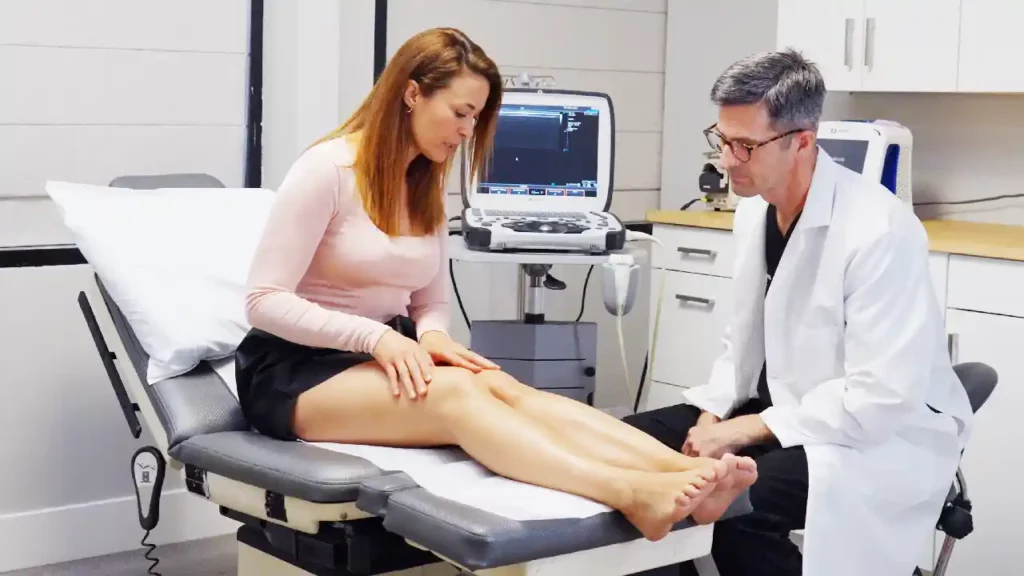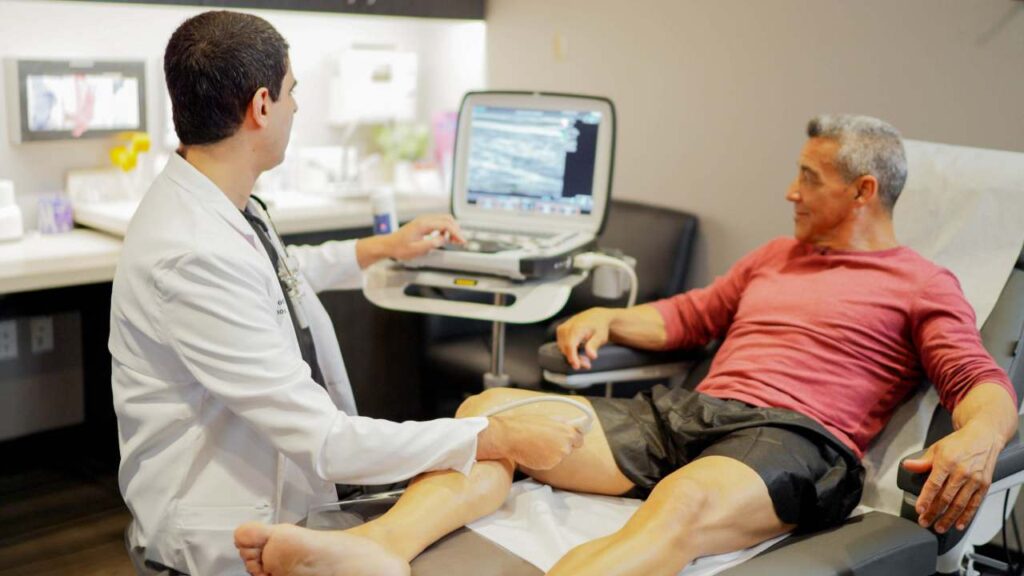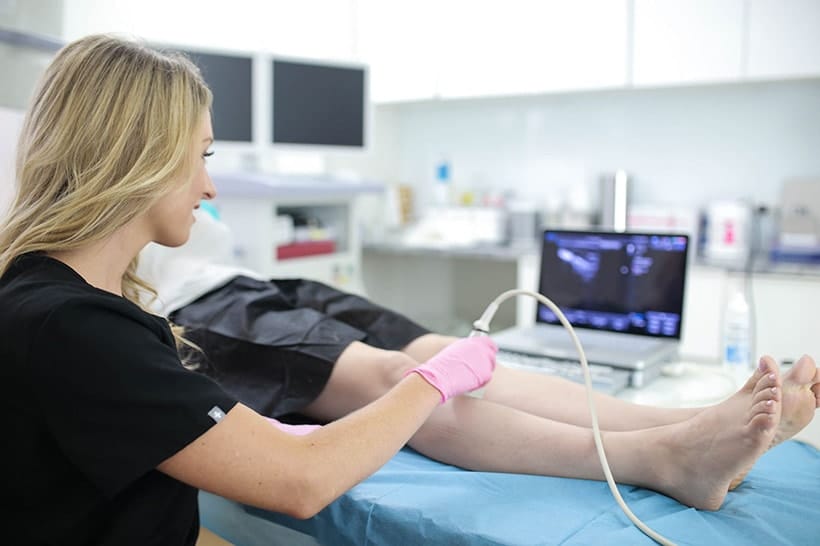What Are Injectable Vein Treatments?
Vein injections are quick and gentle treatments for varicose veins and spider veins. When you hear the phrase “vein injections,” most people are referring to sclerotherapy. In a sclerotherapy treatment, doctors inject a sclerosing solution (sclerosant) into the vein. It’s a detergent-like substance that intentionally irritates the walls of the vein. This causes the vein to swell and seal itself shut. Blood is then rerouted into adjacent veins that can pump it back to the heart. By closing off defective veins, you restore circulatory efficiency, eliminating both the damaged veins and any symptoms that accompany them.
Another way to treat veins with injections is by injecting an adhesive like cyanoacrylate glue into the vein. This also closes the vein, so blood can flow into functional veins. Book an appointment with our Harvard-trained vein doctors in California to learn more about vein injections. The key to a lasting treatment is choosing a vein expert who knows which treatment to use and how to properly administer it.
How Long Does It Take to Inject the Treated Area?
Vein injections take 15-30 minutes, depending on the size of the treated area. They don’t require general, spinal, or local anesthesia, so you are treated as soon as you arrive. Small, surface veins are injected by sight. Deeper, larger veins might require the doctor to use ultrasound guidance. In either case, you can receive vein injections within a lunch break and head straight back to work!
There is no recovery time required, and there are no stitches or incisions to contend with. The doctor uses a tiny, hollow needle that delivers a sclerosant directly to the vein. Some patients have multiple veins to treat, so they might need more than one appointment. But the average patient just needs a single appointment that takes 30 minutes or less.
How Long Does It Take Veins to Disappear After Injections?
Sclerotherapy and vein adhesives both start working immediately. The vein is closed quickly, but it takes a little time to fade from sight. Eventually, it’s harmlessly absorbed by surrounding tissue, which takes a couple of weeks, or for larger veins, a couple of months. If you want your veins to disappear in time for summer, seek treatment in February or March for complete resolution. However, they will be noticeably lighter within a couple of weeks.
How Long Do Vein Injections Last?
They don’t take long to administer, so how long do vein injections last? When done correctly, vein injections are permanent. If the vein doctor successfully closes off the entire damaged portion of the blood vessel, blood no longer enters it. Accumulation of blood in veins is what causes those visible spider veins and varicose veins. By redirecting blood from those veins, you successfully eliminate them.
However, it’s possible for a vein center to use the wrong method or inject insufficient sclerosants. In this case, it’s not that the vein returned, it’s that it wasn’t gone. That’s one reason it’s important to choose a medical center for veins, not a cosmetic vein center. Vein doctors have ultrasound technology to ensure successful closure.
In addition, many patients with spider veins and varicose veins also have an underlying vein disease called Chronic Venous Insufficiency. Unless that’s treated, you can develop new vein damage, which some patients mistake as a recurrence. Our board certified vein doctors treat Chronic Venous Insufficiency, not just spider and varicose veins. We make sure your treatment is permanent, and we prevent new vein damage from developing.
Do They Last the Same for Varicose Veins and Spider Veins?
Sclerotherapy can close spider veins and varicose veins permanently. But it requires the vein doctor to use the right formula. Small spider veins usually need a liquid sclerosant, whereas larger varicose veins might need a foam sclerosant. Foam fills big areas better, coating the walls of twisted veins. Foam can also treat a larger vein without substantially increasing the dosage.
If you have larger veins, doctors can create foam by mixing sclerosants with air, or they can administer pre-mixed foam from a sealed canister. Ask your doctor which type of sclerosant they will use. Qualified vein doctors can use any formulation, but most cosmetic vein specialists are only trained in liquid sclerotherapy.
How Long Will the Injection Site Hurt?
The injection site should not be painful. It might feel sore or be red or bruised for a couple of days. Most patients don’t have any discomfort, other than a temporary hardening sensation beneath the skin when the vein closes. You can resume moderate exercise and all of your usual activities immediately after vein injections.
How Long Do You Wear Compression Stockings Afterward?
Some patients do not need to wear compression stockings at all. For instance, if the injections are applied in your face, arms, or torso, compression therapy isn’t necessary. Leg veins are more prone to backward blood flow, because they must pump blood against gravity while resisting body weight. So, if you have injections in leg veins, your doctor might recommend that you wear compression stockings for a day or two, to help pump blood up and out of leg veins as it follows a new pathway.
Can Vein Injections Cause an Allergic Reaction?
In rare cases, a patient can have an allergic reaction to sclerotherapy. However, it’s typically a mild reaction. It’s similar in severity to contact dermatitis, and it usually resolves quickly on its own. Most vein doctors assess the likelihood of an allergic reaction prior to treatment and offer an alternative like vein adhesives if you’re susceptible.
Do Vein Injections Pose Any Other Risks to Blood Vessels?
Vein injections are one of the safest vein treatments available. They are time-tested, FDA-approved, and have a long track record of safety and efficacy. Unlike other vein treatments, they don’t use anesthesia or thermal energy. The risks are very low when you choose an accredited vein center in California.
For sclerotherapy injections, the main risk is a mild allergic reaction. However, if you seek vein treatment from an unqualified specialist, and you have an undetected blood clot, there’s a risk of the sclerosant breaking that clot loose. So, always choose a trained vein doctor. In their hands, sclerotherapy is far safer than leaving vein damage untreated.
For adhesive injections, there is also a small risk of allergic reaction. Otherwise, it has a low risk profile too. But some patients opt for sclerosants over cyanoacrylate glue because they don’t want an adhesive to remain in their body.
Are You a Good Candidate for Vein Injections?
Sclerotherapy is safe for most patients. To determine whether you’re a good candidate, our vein doctors conduct a medical exam and inquire about your symptoms, preferences, and coexisting conditions. In addition, they’ll analyze the size and location of your damaged veins to decide whether vein injections are best.
If you have an underlying vein disease, they might suggest a different procedure like radiofrequency ablation or endovenous laser treatment to close off broken valves in deeper veins too. But these procedures are also minimally invasive and take 30 minutes or less. Visit our award-winning vein centers in San Diego or San Jose for vein injections that last.






